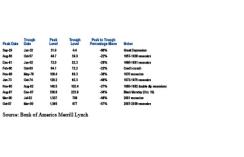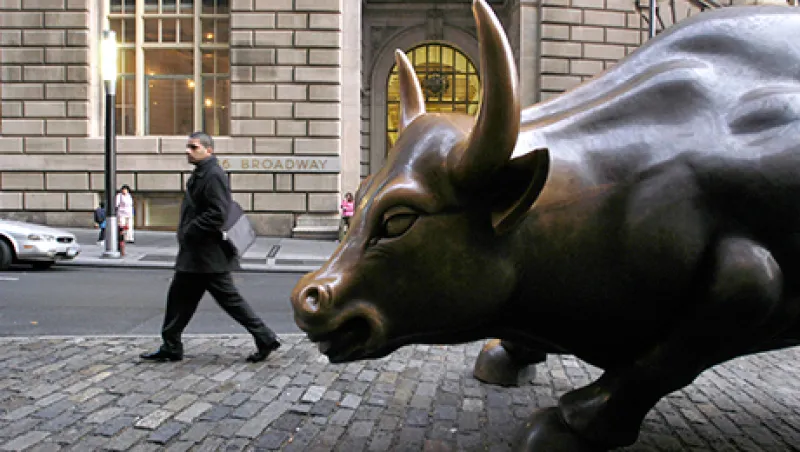When the Standard & Poor’s 500 index plunged 11 percent in eight days last month, some commentators suggested that the move presaged an end to the six-and-a-half-year bull market.
Many market participants say that’s not the case, however, thanks to the economy’s steady growth path. In addition, valuations aren’t excessive, and two contrarian indicators are pointing upward for equities: Money is flowing out of stock funds, and market sentiment remains weak.
As for the economy, “a recession is necessary for the end of a bull market, and the economy is still a long way from recession,” says Charles Lieberman, chief investment officer at Advisors Capital Management, a $1 billion registered investment adviser based in Ridgewood, New Jersey. “There are no overhangs or imbalances in the economy.” He notes that inventories are under control and that the economy has easily absorbed weakness in the energy sector, without consumers seeing much of the benefit of falling oil prices. In addition, strength in the housing and commercial construction markets provides support.
The economy grew 3.7 percent annualized in the second quarter. And though a forecasting model of the Federal Reserve Bank of Atlanta puts third-quarter growth at only 1.5 percent, “an underlying rate of 2.5 to 3 percent is pretty sustainable,” says Dan Suzuki, senior U.S. equities strategist at Bank of America Merrill Lynch in New York. That forecast is stronger than many others.
Suzuki has compiled data (see chart) showing that for ten bear markets — defined as a drop of at least 20 percent — going back to 1929, eight of them began prior to or during a recession. The exceptions were 1987, when the market dropped more than 20 percent in a day, and 1966, when Fed tightening amid fiscal expansion helped produce a credit crunch.

When it comes to valuations, much concern has been raised about the fact that Yale University economics professor Robert Shiller’s cyclically adjusted price-earnings (CAPE) ratio for the S&P 500, which includes ten years of earnings, has reached its fourth-highest level ever, trailing only the precrash periods of 1929, 2000 and 2007. But Shiller himself has noted the limited predictive value of this data.
Many other price-earnings measures stand above their historical averages — but not by large amounts. In any case, it makes sense for P/E ratios to be elevated when interest rates and inflation are low; such an environment drives investors to stocks, say analysts. Bank of America’s normalized P/E ratio, which uses earnings going back to 1987, actually stands 8 percent below its historical average. Even the recent 25.8 level of Shiller’s ratio implies a 6 percent annualized return for the S&P 500 over the next decade, Suzuki points out.
On the flow-of-funds front, “money hasn’t flowed into equities, so it’s not like everybody who is going to invest has done so,” says E. William Stone, chief investment strategist for PNC Wealth Management and PNC Institutional Asset Management in Philadelphia. Investors took a net $4.9 billion out of mutual funds and exchange-traded funds that invest in U.S. stocks during August, according to data from Morningstar. That figure represents the smallest outflow in six months, but the trend is still firmly in place for this contrarian indicator.
Market sentiment is a contrarian indicator too. When investors are optimistic, that often signals a decline is coming. The “sell-side indicator,” Bank of America’s contrarian gauge of Wall Street sentiment, registered at 54 in August. Whereas that represents a 17-month high, it’s still close to the low reached in March 2009. “Sentiment is still pretty cautious, which is positive for stocks,” Suzuki says.
Analysts don’t see the market’s recent volatility as a cause for concern. The CBOE Volatility index (VIX) more than tripled between August 14 and August 24. “We view volatility as a long overdue pause that refreshes,” Stone says. “Over time, if there’s no volatility, you have people building up leveraged positions that make things more dangerous. Weak holders have been wrung out.”
Most analysts forecast a market gain in single-digit percentage points over the next year, given the tempered level of economic and earnings growth. “Moderate growth allows inflation and interest rates to remain low, and that’s a perfect world for the equity market,” Advisors Capital’s Lieberman says. “The Fed does have to raise rates but, without a doubt, will move slowly.” He anticipates stocks will climb 5 to 10 percent during the next 12 months.
So the bears may have to stay in hibernation.
Get more on equities.







